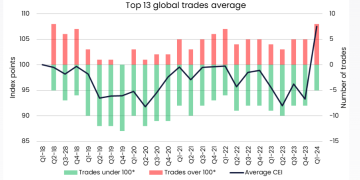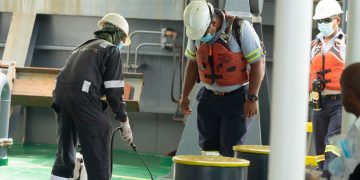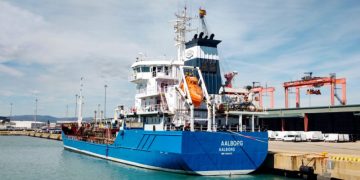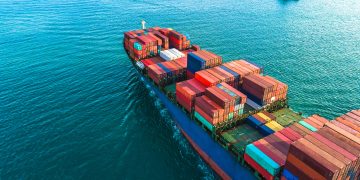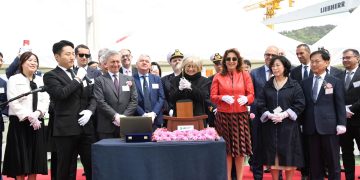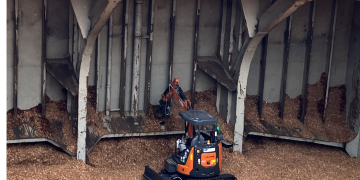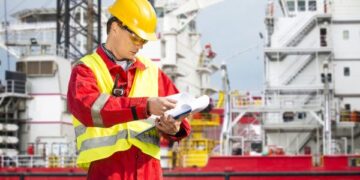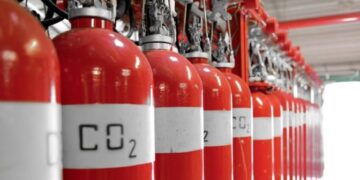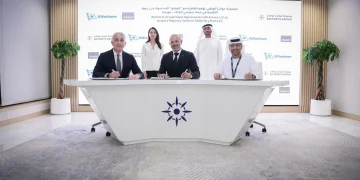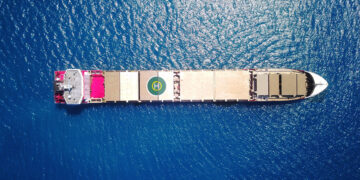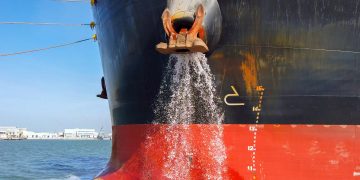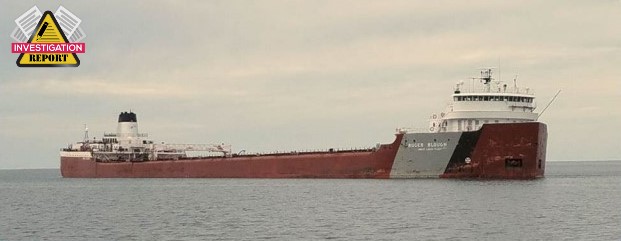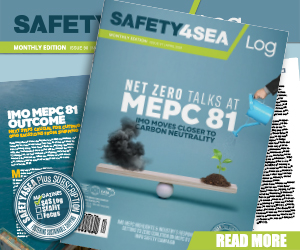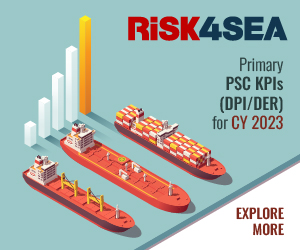NTSB published a accident report regarding a fire that started in the engine room on the Roger Blough during the dry bulk carrier’s winter layup at the Fincantieri Bay Shipbuilding facility on Sturgeon Bay, Wisconsin.
The incident
On Friday, January 29, 2021, shipkeeper no. 2 reported to the Roger Blough for his first day aboard; shipkeeper no. 1 had already been aboard for 2 months. The following day, both shipkeepers conducted engine room cleaning and made gaskets for the water piping systems. On Sunday, January 31, shipkeeper no. 1 departed the vessel at 0900 to attend a weeklong training session. Shipkeeper no. 2, who was living in the bosun’s room on the starboard side of the spar deck in the aft house, departed the vessel at 1900; after returning, he went to bed around 2200.2 He did not recall any problems on board the vessel around this time.
The Roger Blough had a fixed carbon dioxide (CO2) fire-extinguishing system to suppress fires in the engine room; the system was disconnected during winter layup due to the risk of an accidental discharge with workers in the space. Six portable B-II fire extinguishers and one semiportable CO2 fire extinguisher were also in the engine room.
As a safety measure during this layup period, the vessel operator had installed temporarily in the engine room a wireless monitoring and notification system comprised of two smoke detectors, air blower pressure indicators for the sea chest, and bilge-level indicators. The temporary monitoring and notification system was intended to ensure notification when no crewmembers were on board standing watch on the bridge or in the engine room to monitor the vessel’s vital systems. Engine room equipment, such as the vessel’s diesel oil-fired hot air furnace, was not connected to the temporary monitoring system. An alarm panel for the temporary monitoring system was mounted in a passageway on the ship’s spar deck, port side, in the accommodation spaces near the crew’s staterooms. If any issues were detected, the system would activate an audible/visual alarm locally at the panel and notify three designated cell phone contacts via a text message. Another temporary system of smoke detectors was in the crew’s accommodation spaces, including individual staterooms, and sounded locally; it was not connected to the monitoring system.
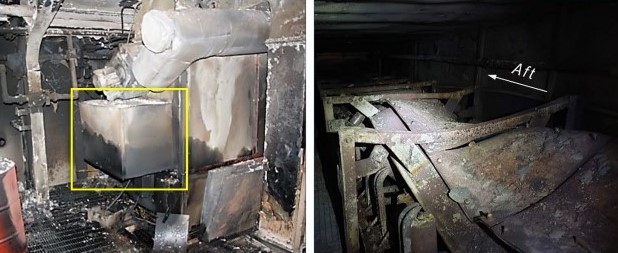
On February 1, at 0131, the monitoring and notification system recorded an alarm indicating there was smoke in the engine room. In the next minute, the system notified the designated contacts: the shipyard’s gate guard, shipkeeper no. 1 (who was not on the vessel), and the cell phone for the Roger Blough (located in the chief engineer’s office). The gate guard noted the alarm and proceeded to the vessel to investigate.
The system was signaled by a smoke detector for the monitoring and notification system on the deck above the furnace (the operating deck). However, the smoke detector in the engine room, which was located on the same deck as the furnace and was 15 feet away, did not signal the system. (No postcasualty testing could be conducted on the engine room smoke detector due to the fire damage.)
About 0138, shipkeeper no. 2 woke to the sound of the smoke detector alarm inside his stateroom and discovered his stateroom was filled with thick, black smoke. Shipkeeper no. 2 then proceeded to the exterior poop deck, where he saw the responding shipyard’s gate guard. Due to the heavy smoke, the shipkeeper, who had no firefighting-protection equipment, did not attempt to reenter the Roger Blough but instead disembarked the vessel via the gangway. The gate guard, having observed the smoke on board emanating from the aft house of the vessel, contacted the Sturgeon Bay Fire Department.
The first units from the fire department arrived at 0143 to fight the fire, which was starting to expand into the galley on the poop deck. Upon assessing the fire, firefighters determined it had traveled through the port and starboard conveyor belt trunks that angled up to the poop deck, to the aft cargo-unloading booms on the spar deck below, and throughout the engine room on the lower deck. The fire was extinguished later that day at 1300. It did not spread to any of the neighboring vessels.
Analysis
At the time of the casualty, the Roger Blough, a bulk carrier designed to operate exclusively on the Great Lakes, had been in winter layup with no reported issues. However, about a month before, the vessel’s diesel oil-fired furnace, which had been installed in the engine room to heat the space during the winter, had stopped operating; it was repaired soon afterward.
When the fire erupted at nighttime, the wireless monitoring and notification system temporarily installed on the vessel for the layup period activated the alarm panel in a passageway within the crew’s accommodation spaces and then notified the three designated contacts. The shipkeeper, the only person on board (and who was not listed as a designated contact), was awakened 7 minutes later by the alarm to the individual smoke detector inside his stateroom as thick black smoke filled it.
By the time the fire department arrived 12 minutes after the designated contacts were notified, the shipkeeper had departed the vessel without injury as the fire was spreading throughout the engine room and up through the aft house of the Roger Blough.
Safety issues identified in this report are as follows:
- The lack of a fire-activated valve on the fuel oil piping to the burner on the furnace in the engine room;
- The lack of regulations governing furnace installation and operation on board certain vessels;
- Inadequate notification to onboard personnel of a fire.
Having completed a comprehensive review of the circumstances that led to the casualty, the investigation excluded the following as a causal factor:
- Shipyard work. While the Roger Blough was undergoing repair work and maintenance by both the shipyard workers and the two shipkeepers in the days before the casualty, there was no evidence that the work and maintenance conducted had any bearing on the circumstances leading up to the fire.
Thus, the NTSB concludes that shipyard work while the vessel was in winter layup was not identified as a safety issue for the casualty.
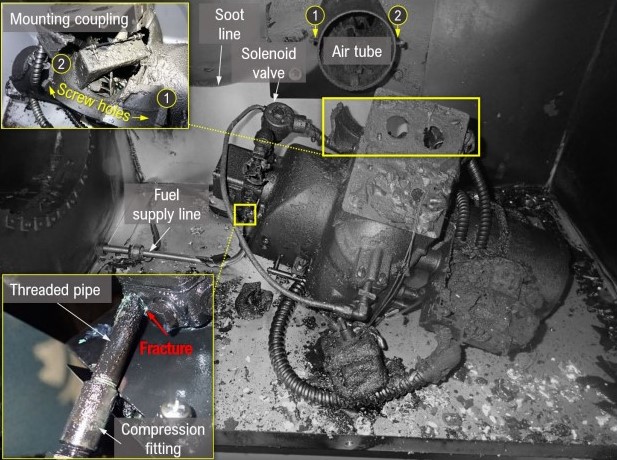
Conclusions
The National Transportation Safety Board determines that the probable cause of the engine room fire aboard the bulk carrier Roger Blough was likely the repeated removal and reinstallation of the furnace’s burner that led to the failure of its mounting coupling, resulting in the operating burner dropping to the bottom of its enclosure and fracturing its fuel supply line, which allowed diesel fuel to ignite.
Contributing to the casualty was the absence of a fire-activated automatic fuel oil shutoff valve on the fuel oil inlet piping before the burner, which would have stopped the fuel feeding the fire shortly after it started and limited the spread of the fire.
In summary, NTSB made the following findings:
- Shipyard work while the vessel was in winter layup was not identified as a safety issue for the casualty.
- The fire originated at the burner inside the diesel oil-fired furnace in the engine room.
- The repeated removal and reinstallation of the burner assembly during ship’s engineers’ attempts to repair it without consulting the manual or the manufacturer may have damaged the mounting coupling and thereby led to its eventual failure.
- The furnace’s burner assembly became detached from the air tube and fell when the mounting coupling fractured, which likely bent and fractured the fuel supply line to the burner, thereby allowing fuel to spray onto the operating burner and ignite within the enclosure.
- Had the burner assembly on the Roger Blough been fitted with a fire-activated quick-closing valve on its inlet fuel oil piping, as recommended by the National Fire Protection Association for shoreside building installations, the fuel feeding the furnace fire would have been stopped and thus the fire likely would not have spread so rapidly.
- The lack of US Coast Guard regulations or American Bureau of Shipping classification standards related to diesel oil-fired air heating furnace construction, installation, safety shutdowns, and system alarms poses a risk to life and property if the equipment is not installed and maintained to standards similar to those in place for other oil-fired equipment.
- If the shipkeeper on board had been listed among the designated contacts to receive alerts from the temporary monitoring and notification system installed on the vessel for winter layup, he likely would have been awakened earlier and thus may have had an opportunity to shut off the fuel and extinguish the fire before it spread through the vessel.



